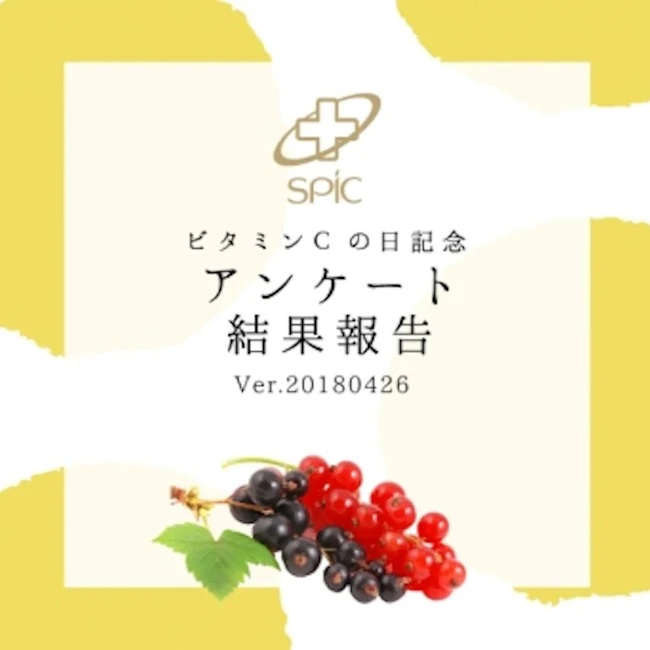
Physicians and consumers, a big gap in vitamin C awareness. Fewer than 5% of users use a regimen that doctors consider effective.
SUMMARY
- ・More than half of the doctors answered that their daily vitamin C intake was "2,000 mg or more," while half of the general consumers answered "less than 1,000 mg," more than double the amount.
- ・Vitamin C ingestion methods recommended by doctors are "intravenous vitamin C at medical institutions" and "vitamin C preparations prescribed by medical institutions". However, less than 5% of general consumers use them.
In parallel with the questionnaires for general consumers so far, we conducted individual questionnaires about vitamin C for doctors, and summarized the questionnaire results of 100 doctors who responded.
The survey of 100 doctors was the first attempt by our company, Spick Co., Ltd., and it was very valuable data.
[Summary of this questionnaire survey]
・More than half of the doctors answered that their daily vitamin C intake was "2,000 mg or more," while half of the general consumers answered "less than 1,000 mg," more than double the amount.
・95% of the doctors answered that they know that the absorption rate of vitamin C varies depending on the method of intake, and more than half of the general consumers answered that they do not know.
・Vitamin C ingestion methods recommended by doctors are "intravenous vitamin C at medical institutions" and "vitamin C preparations prescribed by medical institutions". However, less than 5% of general consumers use them.
There was a large gap between the responses of doctors and the general public.
Each item is explained below.
The required daily intake of vitamin C according to the doctor's answer.
More than half of doctors recommend "2,000 mg or more". Half of general consumers answered “less than 1,000mg”.
In a questionnaire, 100 doctors were asked to answer the numerical value of "the required daily intake of vitamin C", and more than half answered "2,000 mg or more". On the other hand, when the same question was asked to general consumers, about half of the respondents answered "less than 1,000 mg", a contrasting result with doctors. (See diagram below)
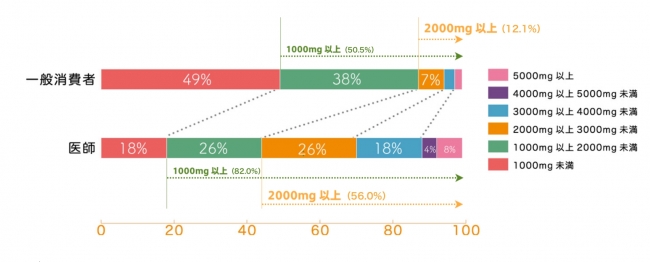
Regarding the "required daily intake of vitamin C", the average value of the general answer was "919mg", while the average value of the doctor's answer was "2,081mg*". On average, physicians reported daily vitamin C requirements more than twice as high as the general public.
* Calculated excluding the response “the more the better”
Most doctors answered that "the absorption rate differs depending on the intake method of vitamin C."
On the other hand, the result is less than half of general consumers.
When asked, "Do you know that the absorption rate differs depending on how you take vitamin C?", 95% of doctors answered, "I know."
On the other hand, less than 40% of the respondents answered “I know” to the same question in the general questionnaire.
The results showed that 60% of people who take vitamin C on a regular basis do not know that the absorption rate differs depending on the method of intake. difference became apparent.
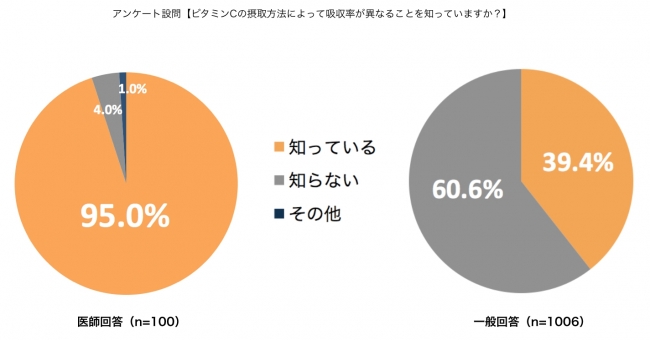
About the effective intake method. Nearly 90% of doctors recognize the effectiveness of "(vitamin C) drip prescribed by medical institutions," but only 1.8% of general consumers use it.
to the doctor, vitamin C "What is the best way to take it?" Regarding, when the assumed intake method was evaluated in 5 stages, Nearly 90% of respondents answered that “(vitamin C) drip prescribed by a medical institution” is “very effective” or “somewhat effective”. Next, about 80% support "oral vitamin C prescribed at medical institutions" As a result, in this survey, the above two intake methods were more popular than "from regular meals".
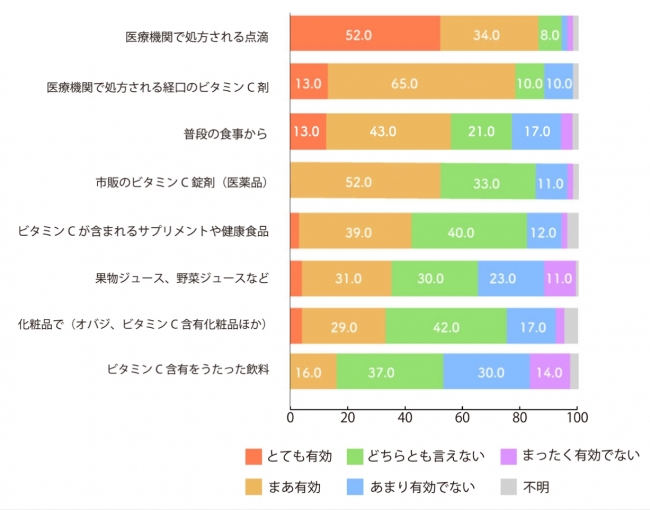
On the other hand, in the general questionnaire, "How do you usually take vitamin C?" This was followed by ``with supplements and health foods'' and ``with beverages such as fruit juices and vegetable juices'', followed by ``intravenous drips prescribed by medical institutions'' and ``oral vitamin C prescribed by medical institutions'' supported by questionnaires for doctors. ” was hardly answered in the general survey, at 1.8% and 4.6%, respectively.
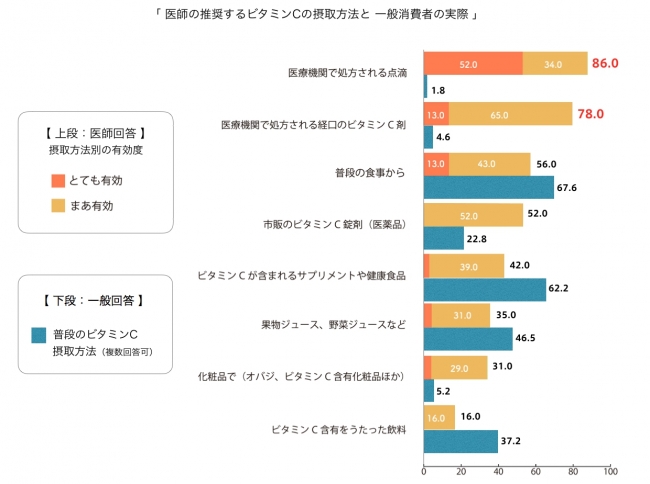
A comparison of the two surveys revealed that people who take vitamin C on a regular basis tend to take it through relatively easy methods such as diet, supplements, and juices. , supports intake methods that are considered to be highly effective and provided at a medical level, such as "intravenous (vitamin C) prescribed by medical institutions" and "oral vitamin C preparations prescribed by medical institutions." It turns out that the “method of intake recommended by doctors” is rarely selected among general consumers.
Problems with vitamin C intake. 'Double gap' in physicians' and public perceptions of vitamin C requirements. Only "less than 5%" use the intake method recommended by doctors. Breakthroughs to overcome challenges.
This time, as a result of comparing the data obtained from the physician survey and the general survey, half of the doctors said that the amount that doctors think they need is "more than twice" the amount that general consumers think is necessary, which is significantly higher than the general perception. It turned out to have a high capacity.
In addition, doctors supported ``vitamin C intake methods provided at the medical level (prescribed intravenous drip, vitamin C preparations)'' as ``effective.''
On the other hand, general consumers tend to consume it only as an extension of their daily diet, and only less than 5% of general consumers actually practice the methods that doctors consider effective. has also become clear.
From the above results, This reveals the issue of intake in that most people are unable to utilize methods that are presumed to be highly effective from a medical perspective.
``While general consumers seek convenience, doctors emphasize effectiveness'' is likely to be common not only to vitamin C but also to other supplements and treatments, and is a trend that is reflected in Japan's medical and health care industry. When considering the future of care culture, it is necessary to always be aware of this difference in attitude.
It seems that there is.
In order to close this gap and enable more effective vitamin C intake in the future, we need to create an environment that allows easy access to "medical-grade" intake methods and develop highly efficient supplements with higher absorption rates. There may be a need for some new breakthrough in vitamin C intake.
[Survey (questionnaire) overview]
<Summary>
・Web survey for consumers in their 20s to 50s (number of responses: 12,731 people)
・Web survey for those who answered that they take vitamin C through supplements or health foods (Number of responses: 1,000 people)
・Fax questionnaire regarding vitamin C targeted at doctors (Number of responses: 100 people)
<Details>
Survey name: Questionnaire survey regarding vitamin C
Survey target: [General] 12,731 men and women in their 20s to 50s nationwide, [Doctors] 100 doctors nationwide who implement vitamin C drip therapy
Number of valid responses: [General] 12,731 (1st survey), 1,000 (2nd survey) [Doctors] 100
Survey period: March 12, 2018 (Monday) to March 19, 2018 (Monday)
Survey method: [General] Internet survey / [Doctor] Fax survey
Research organization: Anterio Co., Ltd.
*1 A web survey was conducted between March 12, 2018 and March 19, 2018 among monitors in their 20s to 50s. The ratio of men to women and gender and age categories (a total of 8 categories: male in his 20s, male in his 30s, male in his 40s, male in his 50s, female in his 20s, female in his 30s, female in her 40s, and female in her 50s) will be equalized. sampled.
*2 From March 12th to March 19th, 2018, in a screening survey, those who answered, ``During the past year, I purchased and drank/ate supplements and health foods for the purpose of ingesting vitamin C.'' A web survey was conducted for those who responded. Sampling was done to ensure that the male to female ratio and the age and gender category ratio were as equal as possible.
*3 A fax questionnaire was sent to 100 doctors who provide vitamin C drip therapy (physicians who consented to the survey after confirming their identity) between March 12, 2018 and March 19, 2018. Implemented.
You can view the survey results here.
1st: Vitamin C is the 4th nutrient! Ranked at the top of the list of nutrients that I know about, that I'm interested in, that I want to consume, and that I regularly consume.
2nd time: Vitamin C awareness survey (questionnaire) results. Are men and women completely different? “What to expect from vitamin C”
3rd: What does vitamin C actually feel like? “Immunity,” “recovery from fatigue/fatigue prevention,” and “effects on the skin” were ranked high.
4th: 90% of enthusiasts don't know about the "Required daily intake of vitamin C"
5th: There is a huge gap in the awareness of vitamin C between doctors and consumers. Less than 5% of people use a method of intake that doctors consider effective.
Recommended articles
・ What are the effects of taking too much vitamin C? What is the recommended daily intake?
・ When is the best time to take vitamin C dietary supplements? Example of timing of intake
・ Is it true that vitamin C causes age spots?
・ Is it better to take vitamin C for health and beauty? Recommended food
・ Which vegetable contains a lot of vitamin C? How to consume effectively



